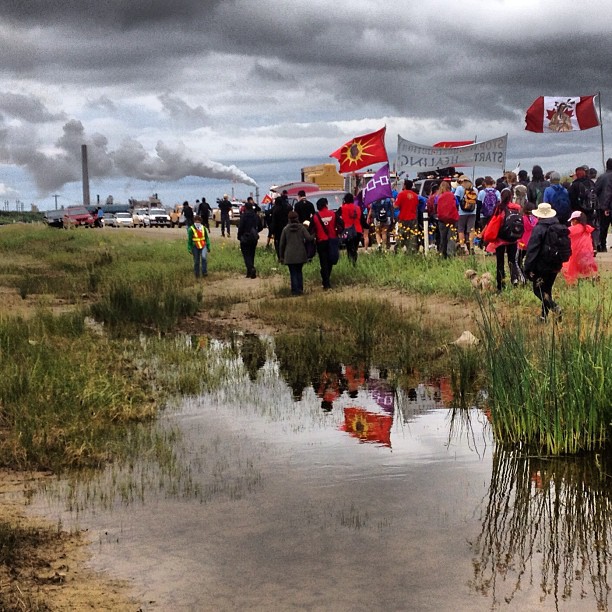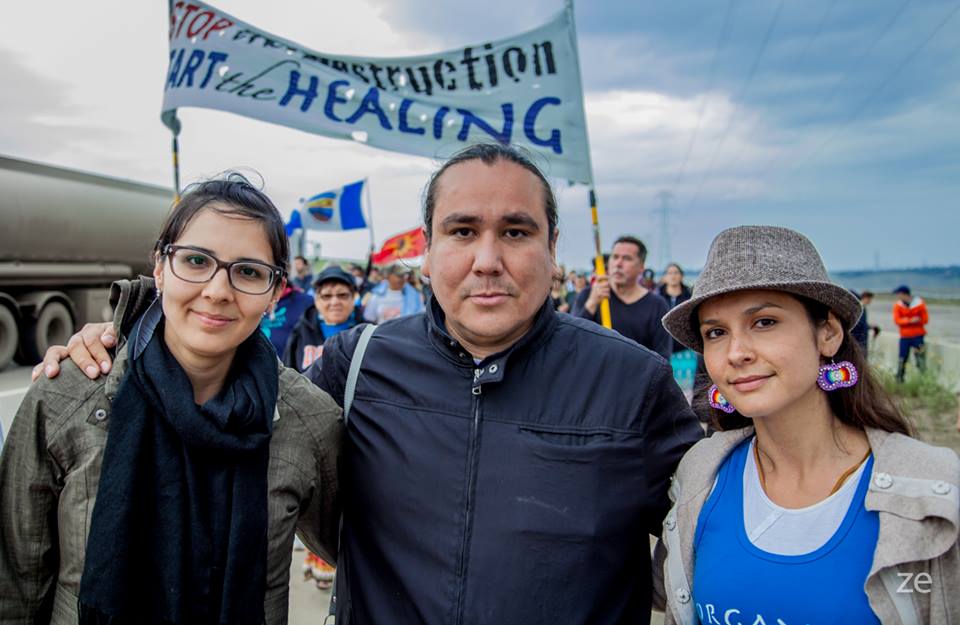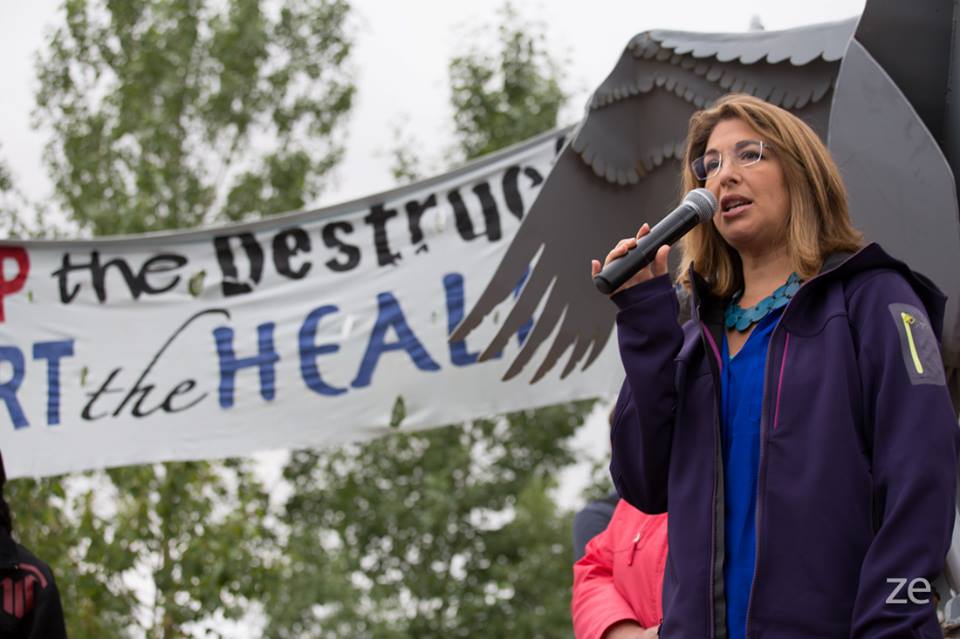
‘North of North’ star Anna Lambe believes (most) people can change
From True Detective to The Grizzlies, the Inuk actor is known for badass roles. She's...
Organizers of the Tar Sands Healing Walk, a 14-kilometre spiritual walk through lands impacted by oilsands (also called tar sands) extraction in northern Alberta, have announced this year’s Healing Walk on June 28th will be the last.
“It was a difficult decision to make,” admits Jesse Cardinal, co-organizer of the Healing Walk. “We felt the original goals of the healing walk of letting local communities know that they had support for the issues of mass industry in the territory and gaining further attention of the issues of tar sands development in a way that was non-aggressive were achieved.”
“Our work will continue in the territory, with the people and communities, but, will look different, so I wouldn’t really call it an end, as a new beginning,” Cardinal told DeSmog Canada. Cardinal is a member of the Kikino Metis Settlement in northeastern Alberta.
The Healing Walk is the only grassroots event to bring people face to face with Canada’s oilsands, one of the largest oil reserves and industrial projects in the world. Participants in the annual event walk through the industrialized landscape, passing by active oilsands facilities releasing toxins into the air, chemical tailings ponds the size of lakes and a barren land in an otherwise lush and green region of Alberta's boreal forest.
But all this is secondary to the Healing Walk’s core theme: hope that the land, water and people drastically impacted by two decades of rapid oilsands extraction will one day heal.
Healing Walk is Not a Protest or a Rally
“We're not going out there for yet another protest, yet another rally. We're out there to be together, to heal, and those two things are very appealing in a context of seemingly endless struggle,” says Chelsea Flook, a Healing Walk organizer since 2010.
“[For participants] the focus on the space being primarily a healing space is a very strong draw,” Flook told DeSmog. Flook is originally from Ontario, but she is currently based in Edmonton and works for the Mother Earth Action Cooperative.
Organizers have been clear from the beginning that the Healing Walk is not a protest. No one shouts out political chants during the walk that takes place just north of Canada’s famous oil town, Fort McMurray. The only banner present is the one leading the procession with the words “Stop the Destruction. Start the Healing” painted on it.

Healing Walk procession in 2013. Photo by Zack Embree.
Instead, participants are led by First Nations elders along the so-called ‘Syncrude Loop’ (oilsands company Syncrude has an operation nearby) as they pray and make offerings in the four directions: north, south, east and west. To complete the loop on foot takes about six hours.
“Making prayers to the four directions woke up the spirit of the land, the water and the people. It has awoken a creative force within the people that will suffocate the destructive force that is the tar sands. That is a pretty powerful warrior to deal with,” says Clayton Thomas-Muller, MC of this year’s Healing Walk and Idle No More campaigner.

Clayton Thomas-Muller with Eriel Deranger of the Athabasca Chipewyan First Nation (left) and Melina Laboucan-Massimo of the Lubicon Cree Nation (right). Photo by Zack Embree.
The Healing Walk is a 3-Day Gathering: Workshops, Communal Meals, Camping
The two days prior to the actual walk have the outward appearance of festival. Tents cluster together (camping is free for participants) in a field on the shores of Lake Gregoire, also called Willow Lake. Communal meals and workshops covering a wide range of oilsands-related issues, from First Nations treaty rights to pipelines, take place at the campsite — an hour’s drive from the starting point of the Healing Walk at Crane Lake Park.
“You come as an individual but you leave as part of the whole which is part of the beauty of the Healing Walk,” says Thomas-Mueller, who is a member of the Missinipi Ethinewak or Big River Cree in Manitoba.
A participant of last year's Healing Walk. Photo by Zack Embree.
“This year, we are focusing mainly on local voices. Some of the people we have speaking, have never been heard of before, but are concerned about what is happening in the Fort McMurray indigenous territory. So more going back to being a grassroots event,” Cardinal says.
Local indigenous voices will include Matthew Whitehead, a traditional knowledge carrier from Fort Chipewyan, Annette Campre and a resident of Fort McKay, who will lead workshops on education and spirituality. The physician who first noticed and researched high rates of cancer among Athabasca Chipewyan First Nation members – Dr. John O’Connor –will speak as part of a health panel.
Last year’s Healing Walk attracted well over 500 people, the largest turnout thus far. Internationally known speakers such as 350.org founder Bill McKibben and author Naomi Klein were among them.

Naomi Klein speaking at last year's Healing Walk event. Photo by Zack Embree.
“At last year’s walk, I saw a fundamental shift in energy that let me know we have already won,” Thomas-Muller told DeSmog Canada.
Will the land ever heal? Organizers are optimistic
For many a ‘win’ for First Nations as well as non-indigenous Canadians over the oilsands industry is hard to see. Despite a few pipeline project delays – notably Keystone XL in the U.S. and Northern Gateway in B.C. – the oilsands industry has expanded rapidly and relatively unimpeded under the current federal government.
And yet Healing Walk organizers believe one day the land they have guided hundreds of people through over the last four years will heal.
“I do believe so, but not in my lifetime," Cardinal says. "The destruction is too big. But way down the road when our existence here is different, and more people have demanded an energy future that isn't destructive to the land, air, water and all living beings will we achieve harmony." Cardinal is a coordinator with the Keepers of the Athabasca, the main organizing group behind the Healing Walk.
A sign designates an industrial area under restoration. Photo by Zack Embree.
“It will take a couple of lifetimes for the land to recover, but a metamorphosis will take place and create new life. Indigenous people will be a part of this and those who do not follow their lead will be left behind. The circle of life will continue,” Thomas-Muller says.
Healing Walk organizer Chelsea Flook, who is not indigenous, believes the only way to get there and avoid the catastrophic effects of runaway climate change at the same time is to follow the lead of indigenous peoples.
“We need to take direction from indigenous communities, to honour their ways of knowing and being. It might mean some awkward dancing between worldviews, it might entail some moments of discomfort,” she says.
“But by supporting Indigenous communities' struggle to protect the land [in the oilsands], we can also fight back against the 'business as usual' plans of industry that entail a six-degree climate warming scenario,” Flook said.
Image Credit: All photos by Zack Embree.
Get the inside scoop on The Narwhal’s environment and climate reporting by signing up for our free newsletter. On March 17, federal Conservative Leader Pierre Poilievre...
Continue reading
From True Detective to The Grizzlies, the Inuk actor is known for badass roles. She's...

Artist Alison McCreesh’s latest book documents her travels around the Arctic during her 20s. In...

I’ve watched The Narwhal doggedly report on all the issues that feel even more acutely...
